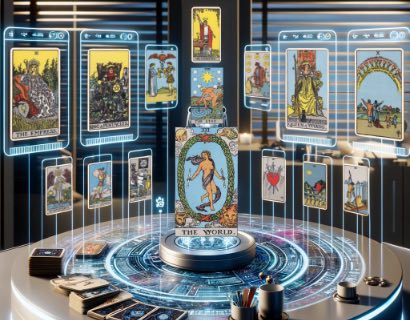|
Deck: Tarocchi Di Marcelo Inciso
by Lynyrd-Jym Narciso. |
Created on Phuture Me |
Also available in our Tarot & Numerology App for Apple iOS & Android
 |
 |
Screenshot
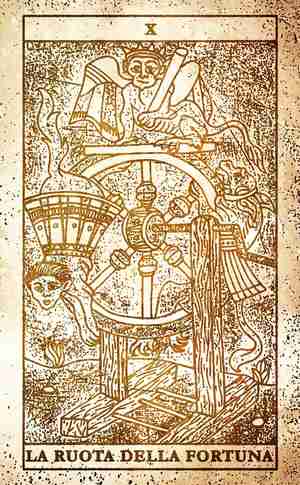
The number 10 marks the beginning of a new cycle after the completion of an old one. In numerology 10 reduces to 1 (1+0=1) which connects it to Tarot's Aces and The Magician. What makes it different is that it begins on top of a preceding cycle whereas the cards numbered 1 symbolise a fresh start with no history or carry over. Therefore The Wheel of Fortune marks a new beginning for something that is already part of your life. Compare The Wheel of Fortune to the 10s of the Minor Arcana which symbolise a new cycle beginning on the foundations of one, or many, previous cycles of their element. In the 10 Of Pentacles this is collective wealth, accumulated over generations of gathering material possessions, beginning a new cycle. Natural cycles are always different. No two years are ever the same. This is why this card is named Wheel of Fortune because the wheel is cyclic and each cycle, each rotation of it, will bring different fortunes, luck, challenges, defeats and success.
The Rider Waite Smith (RWS) deck uses a mixture of Egyptian, Graeco-Roman and Christian symbolism in its depiction of The Wheel of Fortune. In each of the four corners of the card are the "four living creatures" Ezekiel describes in the old testament (Ezekiel 1:1-10) . They are also described in John's vision in Revelation (4:6–8) as sitting around the throne in heaven. Smith and Waite included the same four characters in the corners of The World card of their RWS deck. In The World they symbolise reaching heaven, ascension or enlightenment. In the The Wheel of Fortune they symbolise the notion that one's fate is dictated by Divine Providence. The Wheel is inscribed with two words, their letters inter-changing. "TARO" and the Hebrew "יהוה" (or YHWH in Latin) which Waite states is the "Divine Name" ie the name of God. The world "TARO" can also be read as "ROTA" from the Latin for "wheel". The Sphinx sitting on top of the wheel is a guardian of sorts to balance the inclusion of the serpent on the left and Typhon below the wheel. Typhon is Greek mythology's equivalent to the Christian Devil. A monstrous deity who tried to over throw Zeus and failed only to be cast down and buried under a volcano. The inclusion of these characters is probably to symbolise the unpredictable and chaotic influences that make each cycle of the wheel different.
The Wheel of Fortune symbolises a feeling of something being different about familiar routines or habits. Like beginning a new year at school you are in the same place but a year ahead, studying more advanced subjects with different teachers and timetables. Your failures or successes from the previous year will no doubt play a part in how this year begins. Fate and destiny will also play a part of how this new cycle starts and unfolds. You have to prove yourself once more and there is no guarantee that this cycle will be a repeat of the last one as your fortunes can rise or fall. A simple interpretation of this card can be gambling, or taking a chance.
© Phuture Me Ltd 2010-2019. All rights reserved.
THE PICTORIAL KEY TO THE TAROT
By Arthur Edward Waite (1911)
In this symbol I have again followed the reconstruction of Éliphas Lévi, who has furnished several variants. It is legitimate--as I have intimated--to use Egyptian symbolism when this serves our purpose, provided that no theory of origin is implied therein. I have, however, presented Typhon in his serpent form. The symbolism is, of course, not exclusively Egyptian, as the four Living Creatures of Ezekiel occupy the angles of the card, and the wheel itself follows other indications of Lévi in respect of Ezekiel's vision, as illustrative of the particular Tarot Key. With the French occultist, and in the design itself, the symbolic picture stands for the perpetual motion of a fluidic universe and for the flux of human life. The Sphinx is the equilibrium therein. The transliteration of Taro as Rota is inscribed on the wheel, counterchanged with the letters of the Divine Name--to shew that Providence is imphed through all. But this is the Divine intention within, and the similar intention without is exemplified by the four Living Creatures. Sometimes the sphinx is represented couchant on a pedestal above, which defrauds the symbolism by stultifying the essential idea of stability amidst movement.
Behind the general notion expressed in the symbol there lies the denial of chance and the fatality which is implied therein. It may be added that, from the days of Lévi onward, the occult explanations of this card are--even for occultism itself--of a singularly fatuous kind. It has been said to mean principle, fecundity, virile honour, ruling authority, etc. The findings of common fortune-telling are better than this on their own plane.
Related Tarot Cards
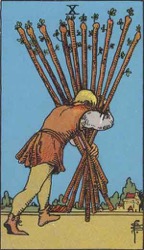 |
 |
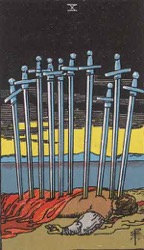 |
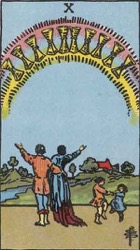 |
 |
© Phuture Me Ltd 2019. All rights reserved.

“Too many cooks spoil the broth.” - English proverb
The Suit of Wands, representing the element of Fire, is symbolic of energy, passion and drive. It is the fire that burns in the home and within the engines of our transport and industry. Tarot cards numbered 5 in the Minor Arcana are all, without exception, problematic. This is not a coincidence but a reflection of the symbology of the number 5. Numerology defines the negative traits of 5 as are being unstable, chaotic, irresponsible or careless. In numerology adjacent numbers have opposite traits. The number 4 is stable and ridged as can be seen in the Rider Waite Smith (RWS) deck's 4 Of Wands with its beautiful 4 sided pergola. In the RWS 6 Of Wands we have a follow on scene from the 5 of Wands where someone responsible has arrived and taken charge of the chaos.
The RWS 5 of Wands is illustrated with 5 men, each holding a wand, doing their own thing without any regard to what the other 4 are doing. There is a total lack of unity in the picture. The element of Fire focuses this disunity in either the home, community or workplace. All the energy and passion, that this element provides, is being wasted due to a lack of singular focus and direction. In A.E Waite's description of the card he suggests that this could be youths at play and this image will remind any parent of the joyful scene of anarchy watching very small children playing in a pre-school group. If play is the objective then there is no need to interfere and bring order to their happy chaos. This card, taken in a positive light, could suggest applying ones energy and passion to athletic pursuits. In numerology the positive traits of the number 5 are being energetic, flexible, adventurous, adaptable and freedom loving. Of the four Minor Arcana cards numbered 5, the 5 of Wands remains open to having a positive or negative meaning. For example another positive meaning of this card could be to interpret it as describing a complex, multifaceted, situation which has many conflicting sides. There is no obvious solution or way forward and perhaps changing its structure, by adding or removing parts of it, could bring about harmony.
In looking for solutions to these problematic 5s it is worth considering the ones presented in the Major Arcana. Unlike the Minor Arcana the major's 5s are not problematic but harmonious. Card 5 of the Major Arcana is The Hierophant which represents institutional, state or religious authority and law. If the RWS 5 of Wands scene is one of 5 builders trying to form a coherent structure from 5 wands then The Hierophant, as a solution, may represent building regulations or architects. The other 5 in the Major Arcana is Temperance which, as card 14, reduces to 5 (1+4=5). Where the The Hierophant represents external control Temperance represents internal control or self control. Temperance reminds us of the number 5's positive traits of being adaptable and flexible.
The 5 of Wands, 5 of Rods or 5 of Batons is a card of disunity, chaos, conflict, struggle, tension and problems in the home, community or work place. The element here is Fire which relates to home, community, work, projects and ambitions. The negative traits of the number 5 in numerology are instability, chaos, irresponsibility and carelessness. The positive traits are being energetic, flexible, adventurous, adaptable and freedom loving.
© Phuture Me Ltd 2010-2019. All rights reserved.
THE PICTORIAL KEY TO THE TAROT
By Arthur Edward Waite (1911)
A posse of youths, who are brandishing staves, as if in sport or strife. It is mimic warfare, and hereto correspond the Divinatory Meanings: Imitation, as, for example, sham fight, but also the strenuous competition and struggle of the search after riches and fortune. In this sense it connects with the battle of life. Hence some attributions say that it is a card of gold, gain, opulence. Reversed: Litigation, disputes, trickery, contradiction.
Related Tarot Cards
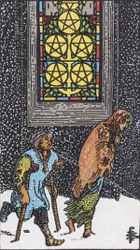 |
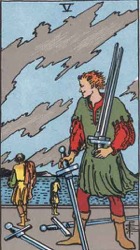 |
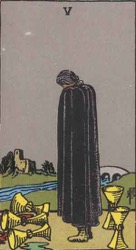 |
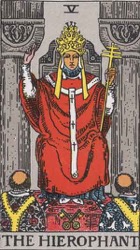 |
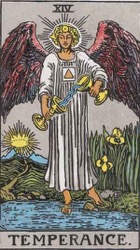 |
© Phuture Me Ltd 2019. All rights reserved.
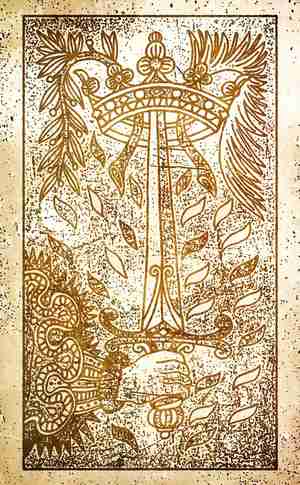
The Ace of Swords imagery remains largely unchanged in Tarot's evolution from the traditional Marseilles deck through the Rider Waite Smith (RWS) deck to its modern derivatives. It has consistently been depicted as a hand holding a single, upright, sword usually with its tip inside a crown or gold ring. The RWS deck added a rocky mountainous landscape to the Ace of Swords and changed the hand, holding the sword, to it coming out of a cloud hovering over the ground. The inclusion of the cloud, as the source of the hand, is there to symbolise the divine origin of all things. It serves to remind us of the greatest mystery of all - where does everything come from, and return to, including ourselves?
Numerology isn't well known or understood but there is no need to explain what the number 1 symbolises to most people. It's the number of a winner, a leader. It is premium and premier. These are the desired traits we all easily associate with 1 but we must remember that 1 is also symbolic of a beginning, a first step in a sequence, cycle or journey. It can also symbolise independence and individualism.
The Ace of Swords symbology is very simple having the element of air and a numerological value of 1. As a 1 it represents a new beginning and, with air as the element, this beginning has to do with new challenges or mental states. This could be a contract, a formal application, a problem needing addressing or new idea. It could be a new focus for the mind, sharpness or clarity of thought, empowering you to cut through a mess of issues and get the the root of a problem. There is an element of success to the Ace of Swords which is emphasised by the crown it often wears. Remember that the number 1 also represents a pinnacle, designates what is premier and symbolises the status of a victor. In the most simplistic interpretation of this card is maybe indicating that something is your 1st choice, best course of action or idea.
The Ace of Swords is connected to the Suit of Swords court cards royalty not only because these characters hold the same upright sword but also because of the crown, or gold ring, encircling it. This connection symbolises the law of the land issued by Royal Decree and the appearance of the Ace of Swords may signify legal matters, proceedings, contracts or constraints. Outside of the Suit of Swords the single upright sword is seen in only one other card, Justice.
© Phuture Me Ltd 2010-2018. All rights reserved.
THE PICTORIAL KEY TO THE TAROT
By Arthur Edward Waite (1911)
A hand issues from a cloud, grasping as word, the point of which is encircled by a crown. Divinatory Meanings: Triumph, the excessive degree in everything, conquest, triumph of force. It is a card of great force, in love as well as in hatred. The crown may carry a much higher significance than comes usually within the sphere of fortune-telling. Reversed: The same, but the results are disastrous; another account says--conception, childbirth, augmentation, multiplicity.
Related Tarot Cards
 |
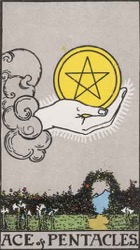 |
 |
|
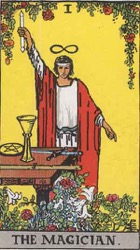 |
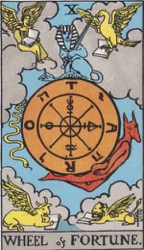 |
 |
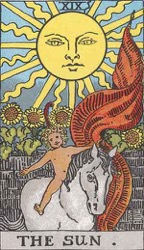 |
© Phuture Me Ltd 2018. All rights reserved.

The element of Fire, represented by the Suit of Wands, symbolises energy, passion and drive. It is the fire that burns in the home and within the engines of our transport and industry. The 4 of Wands is symbolic of a rigid structure, something that is strong, stable, reliable, dependable and trustworthy. There are many ways to interpret this card within these parameters, for example energy, fire and passion contained and controlled in a reliable and safe way. As Fire is symbolic of the home, being the heart of the home, another example would be a safe and secure home environment. Its symbolism is not limited to the home but also encompasses community and place of work. Therefore this card can also symbolise a reliable job which might be a bit mundane and hard work but it would be a reliable source of income.
The characteristics of the number 4 in numerology are immutability, stability, reliability and hard work. It is the number of a strong foundation upon which an enduring structure is constructed. All the cards in Tarot with a numerology of 4 share these characteristic traits. The Kings and The Emperor represent trustworthy and dependable characters on whom you can always rely on within their elemental domain. Even in the troublesome Suit of Swords the 4 Of Swords is symbolic of mental stability. The 4 of Wands symbology, taken from combining its numerology and element, is one of a home, community, job, ambition or project with a strong foundation. This is either past, present or future. In the past this maybe the foundation on which the current and future situation is based. In the present it would represent creating a strong foundation, which will take a lot of hard work and perseverance but will have a long term benefit. In the future it would suggest that plans are being made for the formation of something enduring in the future.
The Rider Waite Smith (RWS) deck depicts the 4 of Wands as 4 staves, as A.E Waite refers to them as, fixed into the ground making a pergola which is adorned with a garland. In the background two well dress women, wearing laurel crowns, hold up bouquets and a crowd of people can be seen further back. The image is one of a celebration but what is being celebrated has been left open to interpretation. A common meaning associated with this card is that it represents a marriage ceremony which is another way of interpreting its symbolism. It would be the initiating foundation of a home through ceremony and celebration. It has to be remembered that this is only the start, the first spade breaking earth or brick being laid, which is sometimes celebrated. A lot of hard work, patience and perseverance will be required long after the party is over to make this work.
The 4 of Wands, 4 of Rods or 4 of Batons, is a card of structure, security and strong roots in a home, community or work place. The element here is Fire which relates to home, community and work. The aspects of the number 4 in numerology are patience, perseverance, hard work, stability and rigidity. For example, the 4 of Wands can point to moving into, and setting up, a new home. The 4 is a rigid and stable number and within the Suit of Wands it can represent the solid foundations of a family, home, community or work place and long term commitments being made.
© Phuture Me Ltd 2010-2018. All rights reserved.
THE PICTORIAL KEY TO THE TAROT
By Arthur Edward Waite (1911)
From the four great staves planted in the foreground there is a great garland suspended; two female figures uplift nosegays; at their side is a bridge over a moat, leading to an old manorial house. Divinatory Meanings: They are for once almost on the surface--country life, haven of refuge, a species of domestic harvest-home, repose, concord, harmony, prosperity, peace, and the perfected work of these. Reversed: The meaning remains unaltered; it is prosperity, increase, felicity, beauty, embellishment.
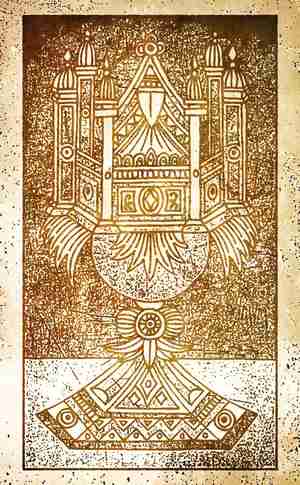
Aces are like plant seeds. These small, self contained, capsules can bring forth something new and, with a bit of luck, the right environment, nurturing and maintenance, can continue to grow and last for many seasons and years. Some don't grow at all and fail early. Some don't turn out as hoped and should be discarded to free space for growing something better. The Ace of Cups can be thought of as an emotional seed. Just as every seed is different so too is every appearance of the Ace of Cups. This card could signify a new friendship which maybe be short lived or may last a life time. It could be a new love interest but not one that progresses as far as a date and is unrequited. Or it may turn into a relationship or platonic friendship. With Aces, just like seeds, you really don't know how it is going to turn out until you try to grow it. All you know is that you have the potential to grow something new.
Numerology isn't well known or understood but there is no need to explain what the number 1 symbolises to most people. It is the number of a winner, a leader. It is premium and premier. These are the desired traits we all easily associate with 1 but we must remember that 1 is also symbolic of a beginning, a first step in a sequence, cycle or journey. It can also symbolise independence and individualism and with the Ace of Cups this would be emotional independence.
The Rider Waite Smith (RWS) deck added a lake covered with lily pads as a background to the Ace of Cups and included a hand, holding the cup, coming out of a cloud hovering over the ground. The Lily is symbolic of chastity and purity. The inclusion of the cloud, as the source of the hand, is there to symbolise the divine origin of all things. It serves to remind us of the greatest mystery of all - where does everything come from, and return to, including ourselves?
The Ace of Cups is traditionally represented as a single vessel filled with water. Its symbology is simple, it has the element of water and a numerological value of 1. As a 1 it represents a new beginning and, with water as the element, this beginning is an emotional one. The card more commonly heralds the coming of a new acquaintance or friend. Since 1's are, in numerology, singular it is less likely to signify a romantic relationship but not impossible. This card is about an individual emotional connection which may not be reciprocated. There are other cards which are more strongly associated with romantic relationship such as the 2 Of Cups, the 10 Of Cups or The Lovers. The Ace of Cups allows the freedom of deciding if and how to grow this emotional connection which may influence the direction it takes at a later stage. The Ace of Cups may also have a link to the Christian symbology of the Holy Grail and its promise of spiritual re-birth and renewal.
© Phuture Me Ltd 2010-2019. All rights reserved.
THE PICTORIAL KEY TO THE TAROT
By Arthur Edward Waite (1911)
The waters are beneath, and thereon are water-lilies; the hand issues from the cloud, holding in its palm the cup, from which four streams are pouring; a dove, bearing in its bill a cross-marked Host, descends to place the Wafer in the Cup; the dew of water is falling on all sides. It is an intimation of that which may lie behind the Lesser Arcana. Divinatory Meanings: House of the true heart, joy, content, abode, nourishment, abundance, fertility; Holy Table, felicity hereof. Reversed: House of the false heart, mutation, instability, revolution.
Related Tarot Cards
 |
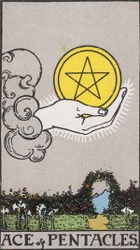 |
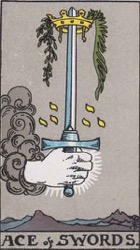 |
 |
 |
 |
© Phuture Me Ltd 2019. All rights reserved.

The Fool is probably the most misunderstood but certainly the most important card in the Tarot deck. In the Rider Waite Smith deck, Arthur E. Waite and Pamela Coleman Smith's Fool is illustrated in a way that leaves The Fool's next step open to interpretation. Most who see this card just take his name and, as the human mind is so good at, fill in what's not there. A cliff and unheeded disaster. But is it a cliff? Could it just be a ledge? Is the dog trying to warn him, or is it just happy and carefree like its companion who is looking towards the heavens. The dog too appears, on closer inspection, to be looking in the same direction. Neither traveler is concerned with the ground falling away in front of them.
The Fool is related to the Pages in the Minor Arcana suits. Each minor page relates to a naive, or foolish, approach to their element. The Fool, just like the other Major courtiers (The Chariot, The Empress and The Emperor ), is a master off all the elements with a focus on the spiritual realm. He walks left, towards the past, which is symbolic of the wrong direction. Beautifully dressed he looks as if he has set out on an adventure in search for something. His focus on heaven symbolises his search for a meaning to life, a higher purpose and destiny. His intentions are good but he lacks experience and wisdom and may be going in the wrong direction. The imagery of The Fool asks a question of us. Who are we to look at someone else and think that they are going in the wrong direction? If their intentions are good, and they are following their heart not their head, how can they be wrong? The following 21 cards in the Major Arcana each symbolise the mysteries The Fool must solve, and lessons he must learn, once he finds the life path he must follow that will guide him to what he is looking for.
The Fool is unique among the Major Arcana for being the only card not to have a number. However some Tarot decks give this card a numerical value of 0 (zero). There is no numerology to constrain The Fool and he, and the Pages, are unique in being free from its cycle of numbers. The Fool represents an individual's journey through the trials of life, marked out by each of the 21 Major Arcana cards, ending with the Ascension to Enlightenment in the final card, The World.
Sometimes we need to follow our hearts not our heads or the perceived wisdom of others and trust in our own intuition.
“Your time is limited, so don’t waste it living someone else’s life.
Don’t be trapped by dogma, which is living with the result of other people’s thinking.
Don’t let the noise of other’s opinions drown out your own inner voice.
And most important, have the courage to follow your heart and intuition.
They somehow already know what you truly want to become.
Everything else is secondary.
Stay Hungry, Stay Foolish ”
- Steve Jobs, 2005 Stanford Commencement Address.
© Phuture Me Ltd 2010-2018. All rights reserved.
THE PICTORIAL KEY TO THE TAROT
By Arthur Edward Waite (1911)
With light step, as if earth and its trammels had little power to restrain him, a young man in gorgeous vestments pauses at the brink of a precipice among the great heights of the world; he surveys the blue distance before him-its expanse of sky rather than the prospect below. His act of eager walking is still indicated, though he is stationary at the given moment; his dog is still bounding. The edge which opens on the depth has no terror; it is as if angels were waiting to uphold him, if it came about that he leaped from the height. His countenance is full of intelligence and expectant dream. He has a rose in one hand and in the other a costly wand, from which depends over his right shoulder a wallet curiously embroidered. He is a prince of the other world on his travels through this one-all amidst the morning glory, in the keen air. The sun, which shines behind him, knows whence he came, whither he is going, and how he will return by another path after many days. He is the spirit in search of experience. Many symbols of the Instituted Mysteries are summarized in this card, which reverses, under high warrants, all the confusions that have preceded it.
In his Manual of Cartomancy, Grand Orient has a curious suggestion of the office of Mystic Fool, as apart of his process in higher divination; but it might call for more than ordinary gifts to put it into operation. We shall see how the card fares according to the common arts of fortune-telling, and it will be an example, to those who can discern, of the fact, otherwise so evident, that the Trumps Major had no place originally in the arts of psychic gambling, when cards are used as the counters and pretexts. Of the circumstances under which this art arose we know, however, very little. The conventional explanations say that the Fool signifies the flesh, the sensitive life, and by a peculiar satire its subsidiary name was at one time the alchemist, as depicting folly at the most insensate stage.
Related Tarot Cards
 |
 |
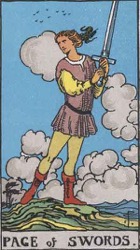 |
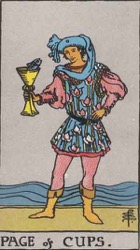 |
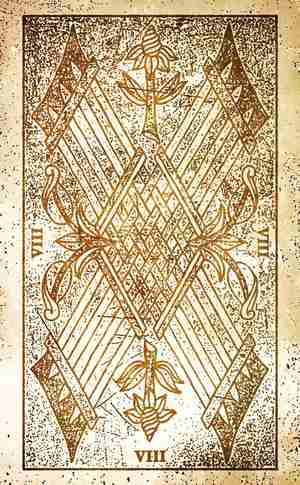
In the 8 of Wands tarot card we have a mix of some very powerful symbology. The Suit of Wands, and its element of Fire, symbolises energy, passion and drive. It is the fire that burns in the home and within the engines of our transport and industry. In numerology the number 8 gives you a "can do, will do" energy and ambition. It puts you in control with the focus to get things done. Not only the ambition but also the direction and resources to manifest goals. Combining the number 8 with the element of fire it would be perfectly correct for a 21st century tarot card to have a picture of a space rocket for the 8 of Wands. Or less dramatic, a cup of very strong coffee!
The Rider Waite Smith (RWS) deck was published at the turn of the 20th century only 6 years after the Wright Brothers achieved the first flight. Had Pamela C. Smith illustrated her deck 100 years later it may well have been a space rocket she would have used. Instead she illustrated what is probably the simplest card in her deck showing 8 wands flying together through the air over a simple, green, countryside. Smith uses the same background from her Ace of Wands but seen from a different perspective. In the Ace things have just started with a single wand being held upright by a hand. In the 8 of Wands things have progressed, multiplied, and are really moving on their own with no hands and no people. The 8 of Wands is the only card in the RWS deck not to feature a character or an additional prop. The The Wheel of Fortune has its Greek, Egyptian and biblical creatures and the 3 Of Swords has its sword pierced heart. The 8 of Wands has nothing other than a simple background and 8 flying wands.
When illustrating a Tarot card there is a danger of influencing the deck user too much by depicting an overly elaborate story which distracts users from the basic symbology. A good Tarot deck should have cards that remain open and fluid to interpretation. To become proficient in Tarot you must always be aware of what is missing as well as what is being presented to you. Smith's decision to exclude any characters, or props, from only this card may have been to emphasise the point that this card relates to forces that have already been set in motion and are out of anyones control. Like arrows that are already in flight one can only wait and see where it is they land, if they hit their target and what damage they do if any.
The 8 of Wands, 8 of Rods or 8 of Batons, is a card symbolising swift action, travel and expansion. The element here is Fire which relates to home, community, work and projects. The aspects of the number 8 in numerology are power, control, ambition, organisation, practicality, focus and success. This card is more commonly depicted as 8 wands flying through the air. This may have the metaphorical meaning of things changing swiftly and for the better. Its meaning can also be literal and the appearance of this card could indicate travel by air in the future.
© Phuture Me Ltd 2010-2019. All rights reserved.
THE PICTORIAL KEY TO THE TAROT
By Arthur Edward Waite (1911)
The card represents motion through the immovable-a flight of wands through an open country; but they draw to the term of their course. That which they signify is at hand; it may be even on the threshold. Divinatory Meanings: Activity in undertakings, the path of such activity, swiftness, as that of an express messenger; great haste, great hope, speed towards an end which promises assured felicity; generally, that which is on the move; also the arrows of love. Reversed: Arrows of jealousy, internal dispute, stingings of conscience, quarrels; and domestic disputes for persons who are married.
Related Tarot Cards
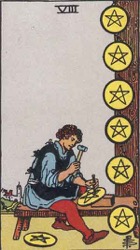 |
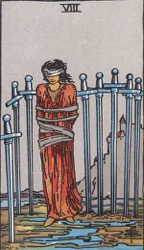 |
 |
 |
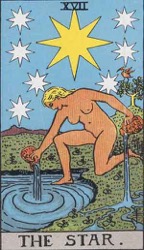 |
© Phuture Me Ltd 2019. All rights reserved.

The Rider-Waite-Smith (RWS) deck depicts the 4 of Pentacles as a minor, modestly dressed, king hoarding 4 pentacles, or coins. He sits on a stone box with a town or city visible in the background. The 4 of Pentacles is the bankers card where wealth is stored and safely guarded. The wealth that is stored there belongs to the King Of Pentacles. This RWS card is an unusual card for two reasons.
The first reason is because the Tarot deck contains only 4 Kings and 1 Emperor but the artist chose to add an additional king in this card. There is also a king in the Death card, lying dead on the ground, because the Kings and The Emperor are linked to Death through their numerological symbolism of the number 4 (Death is 13 which reduces to 4. 1 + 3 = 4). This connection between death and wealth may refer, on rare occasions, to an inheritance.
The second reason is because this character is looking directly at you with his attention in the present moment. This is a rare feature for a minor arcana card as it can only be found in the King Of Swords and the 9 Of Cups where as in the Major Arcana approximately half of the cards in that suit have this symbolism of present moment attention and contentment. Therefore the symbolism portrayed by the king's attention in the 4 of Pentacles is one of being happy with what you have materially even though it is just a modest amount.
The negative aspects of the 4 of Pentacles are depicted in this minor king having each foot on a pentacle embossed coin while tightly clutching one to his chest with both arms. This contentment with your material wealth makes you unwilling to invest, spend or share any of it. This is a stagnant situation which doesn't allow for growth or change. A common trait of the number 4 and part of the symbology of the Kings, the Emperor and Tarot's Death card. If something stagnates, and stops growing and evolving, it risks death and extinction. Life is cyclic and constantly changing, death breaks cycles. As you browse through the cards in the Suit of Pentacles notice how the wealthy and materially prosperous cards are set in rich gardens or lands. The cards without wealth have little or no plant life to be seen and it is in this category the 4 of Pentacles falls.
The 4 of Pentacles, or the 4 of Coins, is a card of financial security, stubbornness, greed and inflexibility. The element here is Earth which relates to wealth and material possessions. The aspects of the number 4 in numerology are security, patience, endurance, restriction, hard work, and rigidity. The 4 is thought of in many cultures as an unlucky number and this card's appearance would not be a good long term omen for personal wealth. Nothing is coming into the bank and although it may seem prudent not to spend in these circumstances it is preventing investment for the future.
© Phuture Me Ltd 2010-2018. All rights reserved.
THE PICTORIAL KEY TO THE TAROT
By Arthur Edward Waite (1911)
A crowned figure, having a pentacle over his crown, clasps another with hands and arms; two pentacles are under his feet. He holds to that which he has. Divinatory Meanings: The surety of possessions, cleaving to that which one has, gift, legacy, inheritance. Reversed: Suspense, delay, opposition.
Related Tarot Cards
 |
 |
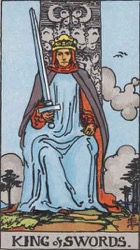 |
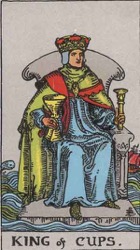 |
 |
© Phuture Me Ltd 2018. All rights reserved.
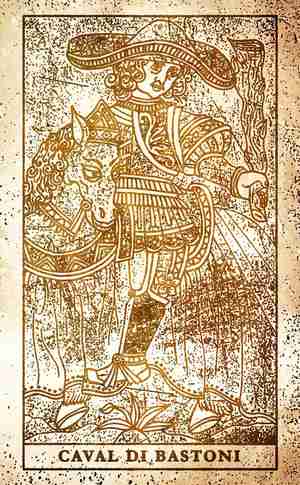
Tarot's Knights, like the Knight of Wands, are related to The Chariot They can be thought of as the Captains of their element, in this case Fire, led by their leader The Charioteer who is warlord of all the elements. As The Chariot is card number 7 of the Major Arcana we can assign any Knight a numerological attribute of 7 by proxy. The numerological traits of the number 7 are rest, inaction, planning, analysing and waiting. A Knight, just like The Chariot, cannot represent attack and should only be defensive. They wear simple, practical, armour without ceremonial, or rank defining, decoration. Helmets, not crowns. Their display is purely one of defending their element.
The Chariot and Knights, with the exception of the Knight of Swords, represent defence. The Rider-Waite-Smith (RWS) Tarot deck emphasised their defensive nature by cladding them in armour. In the older Tarot decks, like the Marseilles, only the Knight of Swords is wearing armour and holding a weapon. The key theme with the Knight of Wands is one of defending ones work or home. The imagery of the card you are looking at should illustrate the mind set. In both the Marseilles and RWS decks the horse backed knight is heading left/east which represents the past. His right hand holds a single wand upright, not forward in an attacking gesture the Knight of Swords. Just as the Ace of Wands signifies a new project, job or home, this card does too but with the caveat that it's being done with caution or resistance.
The Marseilles decks usually depict both the horse and rider heading left/east (the past) but both man and steed are looking backwards west/right (the future). This may indicate a reluctance to engage with something that can be seen approaching from the future. The Rider-Waite-Smith (RWS) Deck changed this feature so both man and horse are facing in the direction they are travelling. In addition to this change the horse is rearing up with it's master pulling so tightly on it's reins that it's head is pulled as far back as it will go. The detail is worth noting as it indicates a need to control power and direction. The Knight wants to remain stationary, or is reluctant to head in that direction, but what is under him is bursting with energy and raring to go. Heading backwards, towards the past, may be taken as the wrong direction. The element of fire can represent the physical energy that one would apply to work and projects but it is also about passion, energy and drive which, if uncontrolled, can be damaging and dangerous. The Marseilles Knight maybe symbolising a reluctance to take on a job or apply ones efforts to something. The RWS Knight may also symbolise keeping control of a project and not allowing other forces to take it in the wrong direction.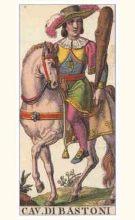
Returning to the theme of defence that runs within the Knight and the Chariot this Knight could signify a need to take defensive measure at home or in the work place. For example home improvements or repairs that maybe needed to prevent damage from the elements. Another example would be guarding, or being defensive about, ones position, or project at work.
The Knight of Wands, also known as the Knight of Rods or Knight of Batons, could be a young* man who has not reached maturity** yet. His vocation in life could be related to the element of fire, home or construction (for example a fire fighter, an architect, an engineer, a carpenter or joiner). The symbolic relationship to this card may not be vocational, it could be a description of his personality. In which case this youth may be passionate, fiery or changeable. He could be someone who prefers to live in the countryside than a town or city. Someone who has a love of nature.
*the age of this man could be relative to the person the reading is for. He maybe a mature man but a younger man.
**maturity happens between ages 28 to 37, when a man enter's his 2nd numerological life cycle.
© Phuture Me Ltd 2010-2019. All rights reserved.
THE PICTORIAL KEY TO THE TAROT
By Arthur Edward Waite (1911)
He is shewn as if upon a journey, armed with a short wand, and although mailed is not on a warlike errand. He is passing mounds or pyramids. The motion of the horse is a key to the character of its rider, and suggests the precipitate mood, or things connected therewith. Divinatory Meanings: Departure, absence, flight, emigration. A dark young man, friendly. Change of residence. Reversed: Rupture, division, interruption, discord.
Related Tarot Cards
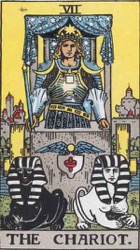 |
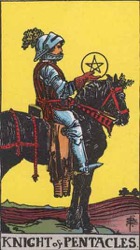 |
 |
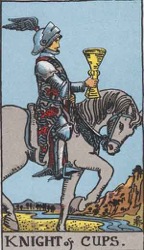 |
© Phuture Me Ltd 2018. All rights reserved.
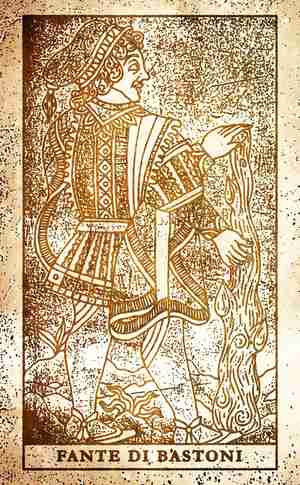
Tarot Page's, like the Page of Wands or Rods, are related to The Fool. They can be thought of as Minor Fool's who's focus is on their element, in this case fire, rather than being spiritually focused like the Major Arcana's Fool.
The central theme of these Fool's is one of not following rational, or conventional, approaches to life. Not caring what other's think (named "fool" because that's what others think) and following one's gut, or instincts. Not being trapped by dogma. Listening to their own inner voice instead of the voices of others. Pages are dreamers and some are capable of turning their dreams into reality.
With the Page of Wands this "foolish" approach is towards the practical day to day aspects of life relating to the home, community and work. The surrounding cards should give clues to this path being a positive, benign or negative one in it's outcome. You may be planning to make some changes to your home and pulled a single card to see if your plans will work out. You get the Page of Wands. Tarot is reflecting your state of mind. You are dreaming of big plans which may take more time and resource than you have. In this instance Tarot is acknowledging your ambition but it should also be raising new questions to ask yourself about this dream you have. Is it just a dream? Do you have the dedication and resources to see it through to reality?
The Page of Wands, as a person, would be a male or female child who could be energetic, creative, inquisitive and maybe enjoys making things.
Pages are also messengers and their appearance in Tarot more commonly signifies a message or news. Of the four Pages in Tarot this one is the most common message barer. Electronic communications, messages that are quickly dispatched and delivered. With the element of fire the theme of the message maybe, but not limited to, work, community and home.
Pay close attention to the details of the imagery for the Page of Wands in your deck. The Rider-Waite-Smith Tarot has a Page looking at the top of his staff or towards the sky. His gaze is in the same direction as the Page of Pentacles. This direction symbolises a mind focused on the future and a higher purpose than earthly matters. There is another card in the Rider-Waite-Smith deck which is the exact opposite in almost every respect to the Page of Wands. That card is The Hermit. There are at least 8 opposite attributes between these cards. See if you can identify them as a useful exercise in recognising symbolic details.
 |
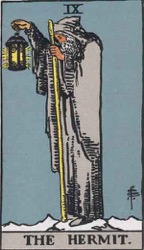 |
© Phuture Me Ltd 2010-2018. All rights reserved.
THE PICTORIAL KEY TO THE TAROT;
By Arthur Edward Waite (1911)
In a scene similar to the former, a young man stands in the act of proclamation. He is unknown but faithful, and his tidings are strange. Divinatory Meanings: Dark young man, faithful, a lover, an envoy, a postman. Beside a man, he will bear favourable testimony concerning him. A dangerous rival, if followed by the Page of Cups. Has the chief qualities of his suit. He may signify family intelligence. Reversed: Anecdotes, announcements, evil news. Also indecision and the instability which accompanies it.
© Phuture Me Ltd 2010-2015. All rights reserved.
Related Tarot Cards
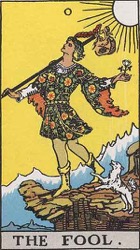 |
 |
 |
 |
Free AI Tarot Reading. Sample the Future!
Artificial Intelligence reads Tarot Cards so well you have to see it to believe it!
We'd love for you to try it for FREE and see for yourself why this excites us.
